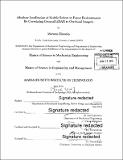| dc.contributor.advisor | Karl lagnemma and Patrick Hale. | en_US |
| dc.contributor.author | Hussein, Marwan | en_US |
| dc.contributor.other | Massachusetts Institute of Technology. Department of Mechanical Engineering. | en_US |
| dc.date.accessioned | 2014-11-24T18:41:58Z | |
| dc.date.available | 2014-11-24T18:41:58Z | |
| dc.date.copyright | 2014 | en_US |
| dc.date.issued | 2014 | en_US |
| dc.identifier.uri | http://hdl.handle.net/1721.1/91877 | |
| dc.description | Thesis: S.M. in Engineering and Management, Massachusetts Institute of Technology, Engineering Systems Division, System Design and Management Program, 2014. | en_US |
| dc.description | Thesis: S.M., Massachusetts Institute of Technology, Department of Mechanical Engineering, 2014. | en_US |
| dc.description | 70 | en_US |
| dc.description | Cataloged from PDF version of thesis. | en_US |
| dc.description | Includes bibliographical references (pages 135-140). | en_US |
| dc.description.abstract | A method for the autonomous geolocation of ground vehicles in forest environments is presented. The method provides an estimate of the global horizontal position of a vehicle strictly based on finding a geometric match between a map of observed tree stems, scanned in 3D by Light Detection and Ranging (LiDAR) sensors onboard the vehicle, to another stem map generated from the structure of tree crowns analyzed from aerial orthoimagery of the forest canopy. Identification of stems from 3D data is achieved by using Support Vector Machine (SVM) classifiers and height above ground filters that separate ground points from vertical stem features. Identifications of stems from overhead imagery is achieved by calculating the centroids of tree crowns extracted using a watershed segmentation algorithm. Matching of the two stem maps is achieved by using a robust Iterative Closest Point (ICP) algorithm that determines the rotation and translation required to align both datasets. The final alignment is used to calculate the absolute location of the vehicle. The localization algorithm has been tested with real-world data and has been able to estimate vehicle geoposition with errors of less than 2.1 m RMS. It is noted that the algorithm's accuracy is currently limited by the accuracy and resolution of the aerial orthoimagery used. This method can be used in real-time as a complement to the Global Positioning System (GPS) and Simultaneous Localization and Mapping (SLAM) in areas where signal coverage is inadequate due to attenuation by the forest canopy, or due to intentional denied access. The method has two key properties that are significant: i) It does not require a priori knowledge of the area surrounding the robot. ii) Based on estimated vehicle state, it uses the geometry of detected tree stems as the only input to determine horizontal geoposition. | en_US |
| dc.description.statementofresponsibility | by Marwan Hussein. | en_US |
| dc.format.extent | 140 pages | en_US |
| dc.language.iso | eng | en_US |
| dc.publisher | Massachusetts Institute of Technology | en_US |
| dc.rights | M.I.T. theses are protected by copyright. They may be viewed from this source for any purpose, but reproduction or distribution in any format is prohibited without written permission. See provided URL for inquiries about permission. | en_US |
| dc.rights.uri | http://dspace.mit.edu/handle/1721.1/7582 | en_US |
| dc.subject | Engineering Systems Division. | en_US |
| dc.subject | System Design and Management Program. | en_US |
| dc.subject | Mechanical Engineering. | en_US |
| dc.title | Absolute localization of mobile robots in forest environments by correlating ground LiDAR to overhead imagery | en_US |
| dc.type | Thesis | en_US |
| dc.description.degree | S.M. in Engineering and Management | en_US |
| dc.description.degree | S.M. | en_US |
| dc.contributor.department | System Design and Management Program. | en_US |
| dc.contributor.department | Massachusetts Institute of Technology. Department of Mechanical Engineering | |
| dc.contributor.department | Massachusetts Institute of Technology. Engineering Systems Division | |
| dc.identifier.oclc | 894363985 | en_US |
